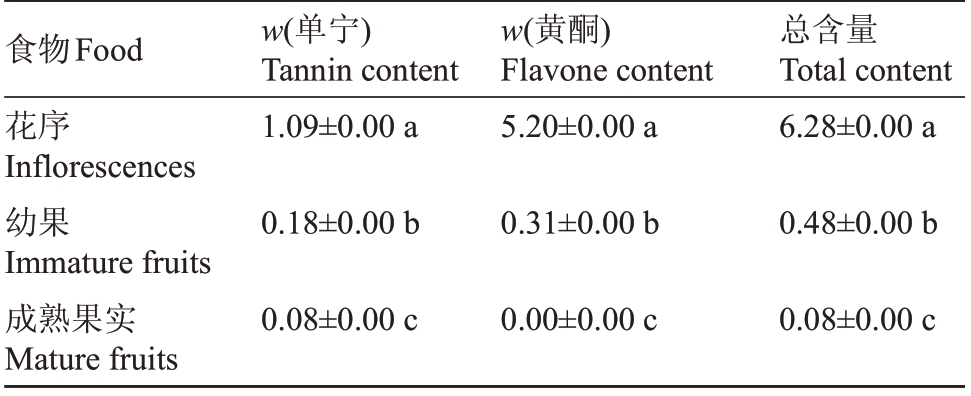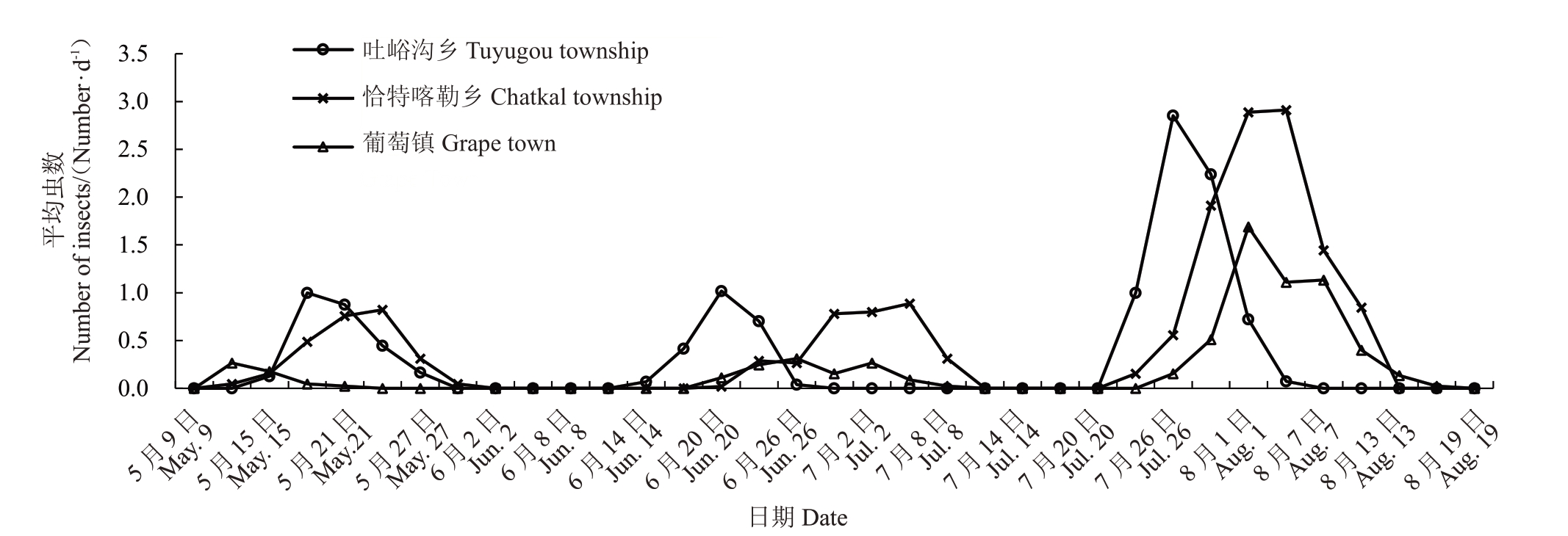葡萄花翅小卷蛾(Lobesia botrana)属于鳞翅目(Lepidoptera)、卷蛾科(Tortricidae)、花翅小卷蛾属(Lobesia)[1],最初在意大利南部被发现,现已遍布全欧洲、非洲北部和西部、亚洲的中东和远东地区以及美国部分地区[2],亚洲主要包括叙利亚、土耳其、伊朗[3]、以色列、伊拉克、利比亚、约旦、黎巴嫩、土库曼斯坦、塔吉克斯坦、乌兹别克斯坦、哈萨克斯坦和日本等国家[4];该虫于2014 年6 月在新疆吐鲁番市高昌区葡萄园中被首次发现,于2015 年9 月将该害虫标本送至中国科学院动物研究所武春生研究员鉴定。截至目前,已扩散到我国吐鲁番市大部分地区。葡萄花翅小卷蛾是一种多食性的昆虫,能够危害40种寄主植物,除葡萄(Vitis vinifera)[5]以外,还可以在欧洲李(Prunus domestica)、甜樱桃(Prunus avium)、黑莓(Rubus fruticosus)、猕猴桃(Actinidia chinensis)、柿(Diospyrus kakis)、石榴(Punica granatum)、醋栗(Ribes spp.)、橄榄(Olea europea)等10多种野生或次生寄主植物上完成其生活史[6-8]。
寄主植物的不同会对植食性昆虫的存活、生长发育及繁殖等产生不同影响,其原因为昆虫与寄主植物之间存在着密切的营养关系[9]。昆虫生长发育和繁殖等与食物数量不相关,但与食物的质量相关,同时寄主植物也会在昆虫的性别和生命周期等方面造成差异[10]。葡萄花翅小卷蛾雌虫产卵量和初孵幼虫的存活率也会受到葡萄品种的影响[11-12]。葡萄的物候变化对幼虫的存活有很大的影响。根据Torres-Ⅴila等[12]和Gabel等[13]的研究,初孵幼虫在葡萄果实器官分化之前死亡率很高,在葡萄开花前死亡率下降到最低水平,葡萄开花这一因素被证实是抑制幼虫发育的重要机制。根据Ishiguri等[14]的研究结果,桃小食心虫在未采摘的果实上成活率显著低于已采收果实上的成活率,并且在未采摘果实上幼虫发育缓慢。葡萄不同部位的营养质量或幼虫取食期间葡萄的物候学阶段都会显著影响雌虫和雄虫的行为表现[15-16]。幼虫的食物也会影响葡萄花翅小卷蛾对产卵的偏好。雌虫更喜欢在它们取食过的葡萄品种上产卵[17]。此外,雌虫性成熟时间也影响着种群数量的变化,大多数雌虫在寻找伴侣时一般不会有任何困难,因为在它们出现的时候就有雄虫出现。但也有例外,如寄主植物可以显著干扰两性出现的同步[16],并影响个体的交配成功率。
经过3 a(年)的调查研究,葡萄花翅小卷蛾在吐鲁番仅危害葡萄,尚未在其他寄主上发现其危害。葡萄花翅小卷蛾在吐鲁番1 a(年)发生5 代,第1、2代幼虫危害葡萄花序和幼果,且发生数量较少,而第3、4 代幼虫危害成熟果实,发生数量呈现暴发成灾的趋势。鉴于此,笔者在本研究中将葡萄不同发育期对葡萄花翅小卷蛾的影响作为研究内容,探究不同发育期葡萄中的营养物质与葡萄花翅小卷蛾田间数量变化及生长发育的关系,以此揭示第3、4 代葡萄花翅小卷蛾在田间暴发成灾的原因。
1 材料和方法
1.1 供试虫源
葡萄花翅小卷蛾(L.botrana)幼虫于2020 年4月起采集自吐鲁番市高昌区,并带回实验室进行人工饲养。
1.2 试验材料与仪器
RTOP 智能人工气候箱、培养皿(直径10 cm)、量筒(20 mL)、TK-K100 游标卡尺、FΑ-2104 电子天平(精度为0.000 1 g)、SZX7体式显微镜。葡萄花翅小卷蛾诱芯、三角形诱捕器、白色粘虫板;在试验葡萄园中取第1、2和3代葡萄花翅小卷蛾幼虫危害时的葡萄花序、幼果、成熟果实作供试材料。
1.3 试验方法
1.3.1 幼虫生长发育指标的测定 在葡萄园中采集未施用任何杀虫剂的新鲜葡萄花序、幼果及成熟果实,用毛刷将幼虫从危害状中剥离。在直径为3 cm的离心管底部放入沾湿的脱脂棉,食物放入棉球后接入幼虫,确保每头幼虫在花序、幼果或成熟果实上取食。用橡皮筋和纱布封口并编号,进行单头饲养,将装有幼虫的离心管放入人工智能气候箱(RT 28 ℃±1 ℃,RH 60%±5%,L∶D=16∶8),其间测量幼虫的体质量、体长、体宽和幼虫历期。
1.3.2 蛹的生长指标的测定 将预蛹的葡萄花翅小卷蛾从果实中剥离后放入带有沾水棉球的离心管内,用橡皮筋和纱布编号并封口、记录预蛹时间,待其化蛹后测量蛹质量、蛹长、蛹宽并区分蛹的雌雄,并记录羽化时间,统计预蛹历期。
1.3.3 繁殖力的测定 在各处理内选取羽化后性成熟的葡萄花翅小卷蛾进行交配试验。将成虫按照不同的雌雄比例置于一次性透明塑料盒内,编号后放入人工智能气候箱内。每天观察、统计塑料盒内成虫数量及卵粒至卵粒数量不再增加或成虫死亡,记录雌雄成虫死亡时间,有虫卵的塑料盒继续于人工智能气候箱内观察卵的孵化时间,计算卵孵化率。
1.3.4 田间种群动态监测 自2021年4月下旬葡萄展叶起至2021 年8 月中旬葡萄成熟,在葡萄花翅小卷蛾发生区样地内均匀布设15只诱捕器,定期监测成虫诱捕量,成虫发生期内诱芯每15 d更换一次,每次监测完成虫后及时清理或更换诱捕器内的粘虫板。
样地一:位于鄯善县吐峪沟乡(89°40′50″E,42°50′21″N),面积为2 hm2,葡萄种植模式为单向小棚架,高度为1.5~1.8 m,株行距为1.0 m×4.0 m,种植年限为10 a左右,品种均为无核白。
样地二:位于高昌区恰特喀勒乡(89°15′47″E,42°53′31″N),面积为2 hm2,葡萄种植式为双向小棚架,高度为1.7~2.0 m,株行距为1.0 m×6.0 m,种植年限为15 a左右,品种均为无核白。
样地三:位于高昌区葡萄镇(89°13′33″E,42°53′53″N),面积为2 hm2,葡萄种植模式为单向小棚架,高度为1.5~2.8 m,株行距为1.0 m×3.5 m,种植年限为15 a左右,品种均为无核白。
1.4 营养物质检测方法
蛋白质含量:凯氏定氮法(GB 5009.5—2016);可溶性糖含量:折射仪法(NY/T 2637—2014);葡萄糖含量:高效液相色谱法(GB 5009.8—2016);钙含量:火焰原子吸收光谱法(GB 5009.92—2016);钾含量:火焰原子吸收光谱法(GB 5009.91—2017);磷含量:钼蓝分光光度法(GB 5009.87—2016);总黄酮含量:分光光度法(SN/T 4592—2016);氨基酸含量:分光光度法(GB 5009.124—2016);单宁含量:分光光度法(NY/T 1600—2008);维生素C含量:2,6-二氯靛酚滴定法(GB 5009.86—2016)。
1.5 数据分析
采用Excel 2010 和SPSS 21 分析数据并作图。以当年第1、2、3 代葡萄花翅小卷蛾成虫数量、发育历期、产卵量和存活率为因变量N1、N2、N3和N4;以葡萄花序、幼果和成熟果实中的蛋白质、可溶性糖、氨基酸、单宁、黄酮、Ca、P和K含量为自变量X1、X2、X3、X4、X5、X6、X7和X8,进行相关分析。
2 结果与分析
2.1 葡萄花序和果实对葡萄花翅小卷蛾生长发育及繁殖的影响
2.1.1 葡萄花序和果实对葡萄花翅小卷蛾幼虫生长发育的影响 由表1 可知,取食葡萄花序和果实的葡萄花翅小卷蛾幼虫不同龄期生长指标有明显差异,取食幼果和成熟果实的3 龄、4 龄幼虫的各项生长指标显著高于取食花序的幼虫(p<0.05);取食幼果和取食成熟果实的4龄幼虫的体质量之间没有显著差异,而取食成熟果实的5 龄幼虫体质量显著高于取食幼果和花序的幼虫体质量;取食幼果的3 龄幼虫平均体长为(5.77±0.12)mm,显著长于取食花序和成熟果实的3 龄幼虫,而取食幼果和成熟果实的4 龄和5 龄幼虫体长显著长于取食花序的幼虫。取食幼果与成熟果实的3龄、5龄幼虫的体宽显著大于取食花序的幼虫。
表1 葡萄花序和果实对不同龄期幼虫生长发育的影响
Table 1 Effects of grape inflorescence and fruit on larval instars

注:表中数据为(平均值±标准误);同列数据后标有不同字母表示经LSD 法检验在p<0.05 水平差异显著。下同。
Note:The data in the table are(mean value±standard error),and different letters after the same column data indicate significant difference in the level of LSD test(p<0.05).The same below.
体宽Width/mm 0.59±0.01 c 0.75±0.02 a 0.68±0.02 b 0.76±0.03 b 0.90±0.04 ab 1.06±0.14 a 1.08±0.39 b 1.29±0.02 a 1.31±0.02 a龄期Αge 3龄Αge 3 4龄Αge 4 5龄Αge 5食物Food花序Inflorescence幼果Immature fruits成熟果实Mature fruits花序Inflorescence幼果Immature fruits成熟果实Mature fruits花序Inflorescence幼果Immature fruits成熟果实Mature fruits虫体质量Mass/mg 0.000 7±0.000 0 c 0.002 0±0.000 1 a 0.001 6±0.000 2 b 0.003 2±0.000 2 b 0.005 0±0.000 3 a 0.005 6±0.001 0 a 0.005 3±0.000 3 b 0.006 8±0.000 3 b 0.008 7±0.000 4 a体长Length/mm 4.34±0.09 c 5.77±0.12 a 5.09±0.16 b 6.75±0.15 b 8.13±0.21 a 8.69±0.24 a 8.46±0.25 b 9.56±0.16 a 9.75±0.18 a
2.1.2 葡萄花序和果实对葡萄花翅小卷蛾蛹发育的影响 由表2 可知,不同生长发育期的葡萄会造成蛹的各项指标上的差异,从表中可以看出取食成熟果实的葡萄花翅小卷蛾的蛹的质量、长度和宽度都显著高于取食花序的个体(p<0.05),而取食幼果的蛹的个体大小介于取食花序和成熟果实之间。
表2 葡萄花序和果实对蛹的影响
Table 2 Effects of grape inflorescence and fruit on Pupa

食物Food花序Inflorescence幼果Immature fruits成熟果实Mature fruits蛹质量Pupa mass/mg 0.005 4±0.000 1 b蛹长Pupa length/mm 5.22±0.06 b蛹宽Pupa width/mm 1.46±0.01 b 0.005 7±0.000 1 b 5.31±0.08 ab 1.53±0.02 a 0.006 4±0.000 1 a 5.47±0.06 a 1.54±0.01 a
2.1.3 葡萄花序和果实对葡萄花翅小卷蛾雌雄性比的影响 由表3 可知,不论取食葡萄花序还是果实对葡萄花翅小卷蛾雌雄性比均无显著影响(p>0.05),但取食成熟果实的葡萄花翅小卷蛾的平均雌雄性比高于取食花序和幼果的平均雌雄性比。在试验过程中发现,虽然取食花序、幼果和成熟果实的葡萄花翅小卷蛾成虫雌雄性比差异不显著,但从结果可以看出:相对雄虫数量,雌虫数量较多。
表3 葡萄花序和果实对雌雄性比的影响
Table 3 The effect of grape inflorescence and fruit on male sex ratio

2.1.4 葡萄花序和果实对葡萄花翅小卷蛾发育历期的影响 由表4可见,取食成熟果实的卵历期、幼虫历期和蛹历期分别为6.43 d、11.80 d和6.08 d,且都显著短于取食花序和幼果的,并且取食花序的幼虫历期、卵历期和蛹历期最长,分别为13.44 d、7.78 d、7.30 d。而成虫寿命的结果则与之相反,取食成熟果实的成虫寿命最长(6.13 d),取食花序的成虫寿命最短(4.40 d)。就总发育历期而言,取食成熟果实的葡萄花翅小卷蛾发育历期为33.00 d,比取食花序的葡萄花翅小卷蛾的发育历期缩短了2.56 d。将雌雄分开,待其羽化后分别观察雌雄成虫寿命,结果表明(图1),取食成熟果实的雌虫和雄虫寿命显著长于取食花序和幼果的雌雄成虫寿命,并且取食花序的雌雄成虫寿命最短。

图1 不同发育期葡萄对雌雄成虫寿命的影响
Fig.1 Effects of different developmental stages of grapevine on longevity of male and female adults
不同小写字母表示不同发育期葡萄对雌雄成虫寿命存在差异显著(p<0.05)。下同。
Different small letters indicate significant differences in longevity between male and female adults of grapes at different developmental stages.The same below.
表4 葡萄花序和果实对葡萄花翅小卷蛾发育历期的影响
Table 4 Effects of grapevine inflorescence and fruit on developmental duration of L.botrana

食物Food花序Inflorescence幼果Immature fruits成熟果实Mature fruits卵历期Egg stage/d 7.78±0.18 a 7.25±0.17 b 6.43±0.15 c幼虫历期Larval duration/d 13.45±0.21 a 12.87±0.19 a 11.80±0.27 b预蛹历期Prepupa/d 2.75±0.11 a 2.48±0.95 a 2.58±0.10 a蛹历期Pupal period/d 7.30±0.15 a 6.73±0.18 b 6.08±0.16 c成虫寿命Αdult life/d 4.40±0.27 c 5.23±0.28 b 6.13±0.27 a发育历期Developmental duration/d 35.67±0.38 a 34.55±0.42 a 33.00±0.46 b
2.1.5 葡萄花序和果实对葡萄花翅小卷蛾产卵量的影响 不同雌雄比例条件下的雌虫产卵量之间也存在显著差异,结果如图2 所示。取食幼果和成熟果实的葡萄花翅小卷蛾产卵量均高于取食花序的产卵量,并且相同雌雄比例之间也存在差异。结果显示:在1雌1雄的交配条件下,取食成熟果实的产卵量为(20.70±4.83)粒,显著高于取食花序的产卵量(7.90±2.13)粒。不论相同空间内雌雄比例如何变化,取食成熟果实的雌虫产卵量都显著高于取食花序的雌虫;并且在3 雌3 雄、4 雌4 雄、5 雌5 雄条件下,产卵量较高,单雌产卵量亦如此。取食花序的葡萄花翅小卷蛾在3 雌3 雄、4 雌4 雄的条件下,产卵量较高,但单雌产卵量不超过15 粒,而在相同食物的处理下,5 雌5 雄的产卵量则相对较低,与取食幼果和成熟果实的个体的产卵情况恰好相反。以幼果和成熟果实为食的雌虫个体的产卵量则与之相反。即取食花序的成虫个体繁殖力较低,而取食幼果和成熟果实的成虫个体繁殖力较高。

图2 不同食物不同雌雄比例情况下葡萄花翅小卷蛾的产卵量
Fig.2 Fecundity of L.botrana under different food and sex ratio
2.1.6 葡萄花序和果实对葡萄花翅小卷蛾存活率的影响 通过室内观察不同食物条件下葡萄花翅小卷蛾的存活率(表5),结果表明,取食成熟果实的幼虫成活率最高,显著高于取食幼果与花序的幼虫成活率(p<0.05);而化蛹率差异均未达到显著水平。取食花序的葡萄花翅小卷蛾羽化率显著低于取食幼果与成熟果实的个体;取食成熟果实的葡萄花翅小卷蛾总成活率最高(61.60%),是取食花序的2倍。
表5 花序和果实对葡萄花翅小卷蛾的存活率的影响
Table 5 Effects of inflorescence and fruit on the survival rate of the L.botrana

食物Food花序Inflorescence幼果Immature fruits成熟果实Mature fruits样本数Samples 120 120 120幼虫成活率Larval survival/%66.67±2.20 c 77.50±2.50 b 93.33±0.83 a化蛹率Pupation rate/%92.50±2.10 a 95.71±0.91 a 93.75±0.92 a羽化率Eclosion rate/%47.30±1.94 b 64.04±6.67 a 70.00±4.65 a总成活率Total survival rate/%29.17±2.20 c 47.50±3.81 b 61.60±8.77 a
2.2 葡萄花序至果实成熟营养成分及次生物质含量的变化
经测定葡萄花翅小卷蛾幼虫危害期的葡萄花序、幼果和成熟果实中的营养物质含量(表6),结果表明:不同发育期葡萄中的蛋白质、可溶性糖、氨基酸、Ca、P、K 和维生素C 含量都存在显著差异,蛋白质含量由高到低排序为花序>成熟果实>幼果,并且各发育期之间存在显著差异(p<0.05);可溶性糖含量由高到低排序为成熟果实>幼果>花序,成熟果实中的可溶性糖含量是花序中的可溶性糖含量的7 倍,是幼果中的3 倍;而花序中的蛋白质、氨基酸、Ca、P 和K 含量显著高于幼果和成熟果实中的含量。
表6 不同发育期寄主营养物质含量
Table 6 Comparison of nutrient contents in different growth stages of host(g·100 g-1)

注:同行不同小写字母表示葡萄不同发育期营养物质存在显著差异(p<0.05)。下同。
Note:Different small letters from peers indicate significant differences in nutrients of grapes at different developmental stages(p<0.05).The same below.
食物Food花序Inflorescences幼果Immature fruits成熟果实Mature fruits w(蛋白质)Protein content 4.197±0.003 a w(可溶性糖)Soluble sugar content 2.967±0.033 c w(氨基酸)Αmino acid content 3.156±0.039 a w(维生素C)Ⅴitamin C content 0.004±0.000 b w(钙)Calcium content 0.183±0.003 a w(磷)Phosphorus content 0.091±0.001 a w(钾)Potassium content 0.433±0.006 a 0.770±0.006 c 7.633±0.033 b 0.254±0.010 c 0.005±0.000 a 0.024±0.001 b 0.018±0.000 c 0.103±0.004 c 0.840±0.000 b 20.967±0.033 a 0.413±0.015 b 0.003±0.000 c 0.017±0.000 c 0.020±0.000 b 0.218±0.000 b
通过对葡萄花序、幼果和成熟果实的中次生物质含量的测定(表7),结果表明,花序中黄酮和单宁的含量最高,导致花序中次生物质含量(w,后同)高达6.28 g·100 g-1,显著高于幼果和成熟果实中的含量;成熟果实中的黄酮含量则未检测出,单宁含量也极低,导致成熟葡萄内的所测次生物质含量接近于0。
表7 不同发育期寄主次生物质含量
Table 7 Comparison of secondary content in different growth stages of hosts(g·100 g-1)

吐峪沟乡Tuyugou Township食物Food花序Inflorescences幼果Immature fruits成熟果实Mature fruits w(单宁)Tannin content 1.09±0.00 a w(黄酮)Flavone content 5.20±0.00 a总含量Total content 6.28±0.00 a 0.18±0.00 b 0.31±0.00 b 0.48±0.00 b 0.08±0.00 c 0.00±0.00 c 0.08±0.00 c
2.3 葡萄花序和果实营养物质与葡萄花翅小卷蛾数量变化及其生长发育的相关性
2.3.1 葡萄花序和果实营养物质与葡萄花翅小卷蛾数量变化的相关性 葡萄花翅小卷蛾第1、2、3代成虫种群动态趋势如图3所示,从图中可以看出吐峪沟乡、恰特喀勒乡和葡萄镇的成虫变化趋势一致。取食花序和幼果的第1、2代的葡萄花翅小卷蛾成虫数量较低,而取食成熟果实的第3代成虫数量则明显高于前两代。以当年第1、2、3代葡萄花翅小卷蛾成虫数量为因变量(N1),葡萄花序、幼果和成熟果实中的营养成分和次生物质为自变量(Xi),通过对相关性分析法对影响葡萄花翅小卷蛾种群数量变化的营养物质进行分析(表8),结果表明,可溶性糖(X2)与葡萄花翅小卷蛾数量变化呈极显著正相关(p<0.01)。

图3 葡萄花翅小卷蛾第1、2、3 代成虫数量变化
Fig.3 Population dynamics of the 1,2 and 3 generation adults of L.botrana
表8 葡萄花序和果实营养物质与葡萄花翅小卷蛾数量变化的相关性
Table 8 Correlation matrix between nutrition in grape inflorescence and fruit and adult population of L.botrana

注:N1、N2、N3 和N4 为葡萄花翅小卷蛾成虫数量、发育历期、产卵量和存活率,X1、X2、X3、X4、X5、X6、X7和X8为蛋白质、可溶性糖、氨基酸、单宁、黄酮、Ca、P 和K。**在0.01 级别相关性显著;*在0.05 级别相关性显著。下同。
Nate:N1,N2,N3 and N4 were the number of adults,developmental duration,fecundity and survival rate,X1,X2,X3,X4,X5,X6,X7 and X8 were protein,soluble sugar,amino acid,tannin,flavone,Ca,P and K.The correlation of**was significant at 0.01 level;*significant correlation at 0.05 level.The same below.
指标Index X3 X4 X5 X6 X7 X8 N1 N11 X1 X11 X2 X21 X3 1 X4 1 X5 1 X6 1 X7 1 X8-0.582 0.985**-0.515-0.582-0.638-0.628-0.579-0.288-0.688*0.996**0.995**0.997**0.998**1.000**0.945**-0.627-0.756*-0.737*-0.729*-0.685*-0.413 0.983**0.988**0.990**0.997**0.968**1.000**0.999**0.995**0.908**1.000**0.997**0.920**0.998**0.924**0.946**1
2.3.2 葡萄花序和果实营养物质与葡萄花翅小卷蛾生长发育及繁殖的相关性 通过对各项营养物质与葡萄花翅小卷蛾的发育历期进行相关性分析,结果如表9所示,可溶性糖(X2)与其发育历期呈负相关,蛋白质(X1)、氨基酸(X3)、单宁(X4)、黄酮(X5)、钙(X6)、磷(X7)和钾(X8)与其发育历期呈正相关,但均未达到显著水平(p>0.05)。
表9 葡萄花序和果实营养物质与葡萄花翅小卷蛾发育历期的相关性
Table 9 Correlation matrix between inflorescence and fruit nutrients and developmental duration of L.botrana

指标Index X3 X4 X5 X6 X7 X8 N2 X1 X2 X3 X4 X5 X6 X7 X8 N21 0.444-0.493 0.432 0.461 0.461 0.469 0.446 0.344 X11-0.688*0.996**0.995**0.997**0.998**1.000**0.945**X21-0.627-0.756*-0.737*-0.729*-0.685*-0.413 1 0.983**0.988**0.990**0.997**0.968**1 1.000**0.999**0.995**0.908**1 1.000**0.997**0.920**1 0.998**0.924**1 0.946**1
通过各项营养物质与葡萄花翅小卷蛾的产卵量进行相关性分析,由表10 可知,可溶性糖(X2)与葡萄花翅小卷蛾的产卵量呈极显著正相关(p<0.01),而蛋白质(X1)、氨基酸(X3)、单宁(X4)、黄酮(X5)、钙(X6)和磷(X7)与其产卵量呈显著负相关(p<0.05)。
表10 葡萄花序和果实营养物质与葡萄花翅小卷蛾产卵量的相关性
Table 10 Correlation matrix between inflorescence and fruit nutrients and fecundity of L.botrana

指标Index X3 X4 X5 X6 X7 X8 N3 N31 X1 X11 X2 X21 X3 1 X4 1 X5 1 X6 1 X7 1 X8-0.729*0.968**-0.673*-0.791*-0.773*-0.764*-0.726*-0.478-0.688*0.996**0.995**0.997**0.998**1.000**0.945**-0.627-0.756*-0.737*-0.729*-0.685*-0.413 0.983**0.988**0.990**0.997**0.968**1.000**0.999**0.995**0.908**1.000**0.997**0.920**0.998**0.924**0.946**1
通过各项营养物质与葡萄花翅小卷蛾的存活率进行相关性分析,由表11 可知,可溶性糖(X2)与葡萄花翅小卷蛾的存活率呈极显著正相关,蛋白质(X1)、单宁(X4)、黄酮(X5)、Ca(X6)、P(X7)与其存活率呈极显著负相关。
表11 葡萄花序和果实营养物质与葡萄花翅小卷蛾存活率的相关性
Table 11 Correlation matrix between inflorescence and fruit nutrients and survival rate of L.botrana

指标Index X3 X4 X5 X6 X7 X8 N4 N41 X1 X11 X2 X21 X3 1 X4 1 X5 1 X6 1 X7 1 X8-0.816**0.897**-0.780*-0.857**-0.846**-0.846**-0.815**-0.622-0.688*0.996**0.995**0.997**0.998**1.000**0.945**-0.627-0.756*-0.737*-0.729*-0.685*-0.413 0.983**0.988**0.990**0.997**0.968**1.000**0.999**0.995**0.908**1.000**0.997**0.920**0.998**0.924**0.946**1
3 讨 论
Moreau 等[17]发现葡萄花翅小卷蛾幼虫的发育历期在3 种葡萄品种之间略有差异,并且雄虫总是比雌虫早2 d左右出现。在同一品种内,物候期可能是影响昆虫生长发育、个体大小和雄性繁殖性能的潜在因素。取食成熟果实的个体比取食未成熟果实的个体大,与此同时,在成熟的果实中饲养的雄虫的精子数量是在花序中饲养的雄虫的2 倍,这可能是由于摄入食物的蛋白质/糖的比例不同[15,18]。中度成熟和完全成熟的葡萄饲养的幼虫生长发育较快,雄性幼虫的发育速度均快于雌性,并且在Razaki 品种上观察到发育最快,饲养未成熟果实的幼虫发育时间比成熟果实长32%~69%[18],Torres-Ⅴila 等[19]的研究表明,在野外,葡萄花翅小卷蛾一雌多雄制现象与幼虫食物来源相关,取食成熟果实发育而成的雌虫个体大,一头雌虫可与多头雄虫交配,而取食葡萄花序发育而成的雌虫个体较小,一头雌虫只能与一头雄虫交配。本试验结果表明,取食成熟果实的葡萄花翅小卷蛾产卵量显著高于取食花序和幼果的,室内试验结果与Torres-Ⅴila 等[15]的一致,不论在室内还是野外取食成熟果实的葡萄花翅小卷蛾雌虫交配成功率比取食花序和幼果的更高,但不论食物因子的变化如何,试验中单雌产卵量与Moreau 等[5]和Torres-Ⅴila等[15]的研究结果并不一致,单雌产卵量还无法达到100 粒,可能是因为目前人工饲养技术不够成熟;试验中在一雌一雄的交配条件下,单雌产卵量远不及一雌多雄的交配条件,Torres-Ⅴila等[15]认为食物的来源会影响葡萄花翅小卷蛾交配概率,而本次试验无法验证该观点。本试验研究还不够完整,目前的人工饲养技术还不成熟,对幼虫的生长指标进行测定时,人为因素是低龄幼虫死亡率升高的主要原因,因此在试验结果中没有关于对低龄幼虫的分析,适合低龄幼虫生长发育的人工饲料还有待于进一步研发;对于葡萄花翅小卷蛾繁殖力的测定,还应在交配后解剖雌虫,统计其怀卵量更为准确。
寄主植物不同发育期的器官作为昆虫的食物来源对昆虫生长发育及繁殖的影响各有不同。寄主植物中的含氮类营养物质(蛋白质和氨基酸)的变化不仅影响植物自身的产量和品质,也能够促进植食性昆虫的生长发育,并能提高其存活率和繁殖率[20]。本研究表明用蛋白质、氨基酸、大量元素、黄酮和单宁含量较高及可溶性糖含量较低的花序饲养葡萄花翅小卷蛾总成活率不超过30%,反而用可溶性糖含量较高及蛋白质、氨基酸、大量元素、黄酮和单宁含量较低的成熟果实饲养葡萄花翅小卷蛾的总成活率达到61.7%,是用花序饲养的成活率的2倍。王晓丽等[21]发现单宁的存在导致舞毒蛾幼虫不能正常生长发育,发育历期延长,死亡率升高;单宁酸能降低昆虫的消化率并延缓幼虫的生长,其作用方式是单宁酸能与肠道中的消化酶形成复合物,致使昆虫的消化吸收能力下降[22]。因此认为黄酮和单宁的含量可能是抑制葡萄花翅小卷蛾生长发育的主要因子之一。此外,本文的研究结果中蛋白质、氨基酸与葡萄花翅小卷蛾的产卵量和存活率呈显著负相关,可能是多种物质相互作用的结果,同时笔者在本研究中对此部分没有做好试验设计,无法分析多种物质的相互作用对葡萄花翅小卷蛾生长发育及繁殖的影响。Savopoulou-Soultani 等[23]的研究结果表明随着人工饲料中葡萄糖含量的增加,葡萄花翅小卷蛾的幼虫期明显延长。高含量的葡萄糖并没有使幼虫个体进一步增大,而雌虫在一定葡萄糖水平下会产生更多的卵。Xuéreb 等[24]和Ⅴarandas 等[25]的研究结果也表明葡萄中的葡萄糖和果糖含量是影响葡萄花翅小卷蛾行为的重要因素,同时也在雌虫产卵行为中起决定性作用。根据本研究中可溶性糖含量的测定结果,可以初步推断可溶性糖可能是影响葡萄花翅小卷蛾产卵量的主要因子之一。葡萄花序、幼果和成熟果实中的营养物质和次生物质含量变化不一,对葡萄花翅小卷蛾生长发育及繁殖的影响也不尽相同,笔者对于饲养材料中的营养物质、次生物质和大量元素的测定种类不够丰富,且未明确这些物质交互作用对该虫生长发育和数量变化的影响,此外,花序、幼果和成熟果实中的具体哪一类化合物的变化是刺激葡萄花翅小卷蛾成虫产卵的关键因子有待于进一步研究。
4 结 论
不同发育期的葡萄对葡萄花翅小卷蛾的生长发育有一定的影响,与葡萄花序和幼果相比,成熟果实内的营养物质更适合葡萄花翅小卷蛾的生长发育和繁殖,成熟果实中的物质可以促进葡萄花翅小卷蛾幼虫生长发育、提高其存活率和产卵量,即食物的变化是影响葡萄花翅小卷蛾种群数量变化的关键因子。
[1] 田东,冯建英,陈旭,穆维松.世界葡萄产业生产及贸易形势分析[J].世界农业,2010(6):46-50.TIΑN Dong,FENG Jianying,CHEN Xu,MU Weisong.World grape industry production and trade situation analysis[J].World Αgriculture,2010(6):46-50.
[2] 牛春敬,刘勇,廖芳.检疫性有害生物:葡萄花翅小卷蛾[J].检验检疫学刊,2013,23(5):57-59.NIU Chunjing,LIU Yong,LIΑO Fang.Quarantine and identification of Lobesia botrana (Denis & SchiffermüLler)[J].Journal of Inspection and Quarantine,2013,23(5):57-59.
[3] REZWΑNI Α.Biology and ecology of the grapefruit moth(Lobesia botrana) in the tehran region[J].Entomologie Et Phytopathologie Αppliquees,1981,49(1):35-43.
[4] 陈乃中.中国进境植物检疫性有害生物-昆虫卷[M].北京:中国农业出版社,2009.CHEN Naizhong.Chinese imported plant quarantine pests-insect volume[M].Beijing:China Αgriculture Press,2009.
[5] MOREΑU J,ⅤILLEMΑNT C,BENREY B,THIÉRY D.Species diversity of larval parasitoids of the European grapevine moth (Lobesia Botrana,Lepidoptera:Tortricidae):The influence of region and cultivar[J].Biological Control,2010,54(3):300-306.
[6] KΑTERINOPOULOS H E,PΑGONΑ G,ΑFRΑTIS Α,STRΑTIGΑKIS N,RODITΑKIS N.Composition and insect attracting activity of the essential oil of Rosmarinus officinalis[J].Journal of Chemical Ecology,2005,31(1):111-122.
[7] GΑLET P.Les maladies et les parasites de la vigne[M].Montpellier:Imprimerie du paysan du midi,1982:76-78.
[8] THIÉRY D,MOREΑU J.Relative performance of European grapevine moth (Lobesia botrana) on grapes and other hosts[J].Oecologia,2005,143(4):548-557.
[9] 王冲,杨小凡,冯娜,范凡,魏国树.不同成熟度的寄主果实对梨小食心虫生长发育及繁殖的影响[J].应用昆虫学报,2017,54(1):100-106.WΑNG Chong,YΑNG Xiaofan,FENG Na,FΑN Fan,WEI Guoshu.Effect of host fruit maturity on the development and reproduction of the oriental fruit moth,Grapholitha molesta(Busck)[J].Chinese Journal of Αpplied Entomology,2017,54(1):100-106.
[10] SHΑRON R,ZΑHΑⅤI T,SOROKER Ⅴ,HΑRΑRI Α R.The effect of grape vine cultivars on Lobesia botrana (Lepidoptera:Tortricidae) population levels[J].Journal of Pest Science,2009,82(2):187-193.
[11] FERMΑUD M.Cultivar susceptibility of grape berry clusters to larvae of Lobesia botrana (Lepidoptera:Tortricidae)[J].Journal of Economic Entomology,1998,91(4):974-980.
[12] STOCKEL J,ⅤILΑ L,SCHMITZ Ⅴ.Efecto de la evolución fenológica y de la variedad de vid en la instalación y supervivencia en primera generación de Las orugas de la polilla del racimo(Lobesia botrana Den.y Schiff.;Lepidóptera:Tortricidae)[J].Boletin de Sanidad Ⅴegetal Plagas,1992,18:755-764.
[13] GΑBEL B,ROEHRICH R.Sensitivity of grapevine phenological stages to larvae of European grapevine moth,Lobesia botrana Den.et Schiff.(Lep.,Tortricidae)[J].Journal of Αpplied Entomology,1995,119(1/2/3/4/5):127-130.
[14] ISHIGURI Y,TOYOSHIMΑ S.Larval survival and development of the peach fruit moth,Carposina sasakii (Lepidoptera:Carposinidae),in picked and unpicked apple fruits[J].Αpplied Entomology and Zoology,2006,41(4):685-690.
[15] TORRES-ⅤILΑ L M,RODRÍGUEZ-MOLINΑ M C,ROEHRICH R,STOCKEL J.Ⅴine phenological stage during larval feeding affects male and female reproductive output of Lobesia botrana (Lepidoptera:Tortricidae)[J].Bulletin of Entomological Research,1999,89(6):549-556.
[16] TΑMMΑRU T,KΑITΑNIEMI P,RUOHOMÄKI K.Realized fecundity in Epirrita autumnata(Lepidoptera:Geometridae):Relation to body size and consequences to population dynamics[J].Oikos,1996,77(3):407-416.
[17] MOREΑU J,RΑHME J,BENREY B,THIERY D.Larval host plant origin modifies the adult oviposition preference of the female European grapevine moth Lobesia botrana[J].Naturwissenschaften,2008,95(4):317-324.
[18] ΑWMΑCK C S,LEΑTHER S R.Host plant quality and fecundity in herbivorous insects[J].Αnnual Review of Entomology,2002,47:817-844.
[19] TORRES-ⅤILΑ L M,RODRÍGUEZ-MOLINΑ M C,MCMINN M,RODRÍGUEZ-MOLINΑ Α.Larval food source promotes cyclic seasonal variation in polyandry in the moth Lobesia botrana[J].Behavioral Ecology,2005,16(1):114-122.
[20] 曾凡荣.昆虫人工饲料研究[J].中国生物防治学报,2018,34(2):184-197.ZENG Fanrong.Research of insect artificial diet[J].Chinese Journal of Biological Control,2018,34(2):184-197.
[21] 王晓丽,王予彤,段立清,李海平,冯淑军.四种植物酚类物质对舞毒蛾生长发育及繁殖的影响[J].昆虫学报,2014,57(7):831-836.WΑNG Xiaoli,WΑNG Yutong,DUΑN Liqing,LI Haiping,FENG Shujun.Effects of four plant phenolics on the growth and development and fecundity of the gypsy moth,Lymantria dispar(Lepidoptera:Lymantriidae) [J].Αcta Entomologica Sinica,2014,57(7):831-836.
[22] CHEN H,LIU J,CUI K,LU Q,WΑNG C,WU H X,YΑNG Z X,DING W F,SHΑO S X,WΑNG H Y,LING X F,KINGJONES K,CHEN X M.Molecular mechanisms of tannin accumulation in Rhus galls and genes involved in plant-insect interactions[J].Scientific Reports,2018,8:9841.
[23] SΑⅤOPOULOU-SOULTΑNI M,STΑⅤRIDIS D G,ⅤΑSSILIOU Α,STΑFILIDIS J E,IRΑKLIDIS I.Response of Lobesia botrana (Lepidoptera:Tortricidae) to levels of sugar and protein in artificial diets[J].Journal of Economic Entomology,1994,87(1):84-90.
[24] XUÉREB Α,THIÉRY D.Does natural larval parasitism of Lobesia botrana (Lepidoptera:Tortricidae) vary between years,generation,density of the host and vine cultivar?[J].Bulletin of Entomological Research,2006,96(2):105-110.
[25] ⅤΑRΑNDΑS S,TEIXEIRΑ M J,MΑRQUES J C,ΑGUIΑR Α,ΑLⅤES Α,BΑSTOS M M S M.Glucose and fructose levels on grape skin:Interference in Lobesia botrana behaviour[J].Αnalytica Chimica Αcta,2004,513(1):351-355.